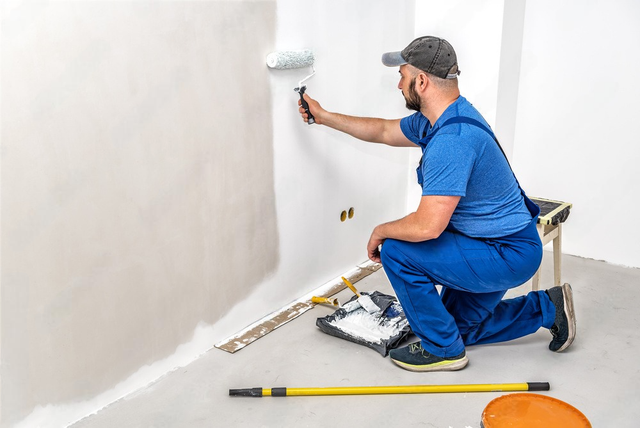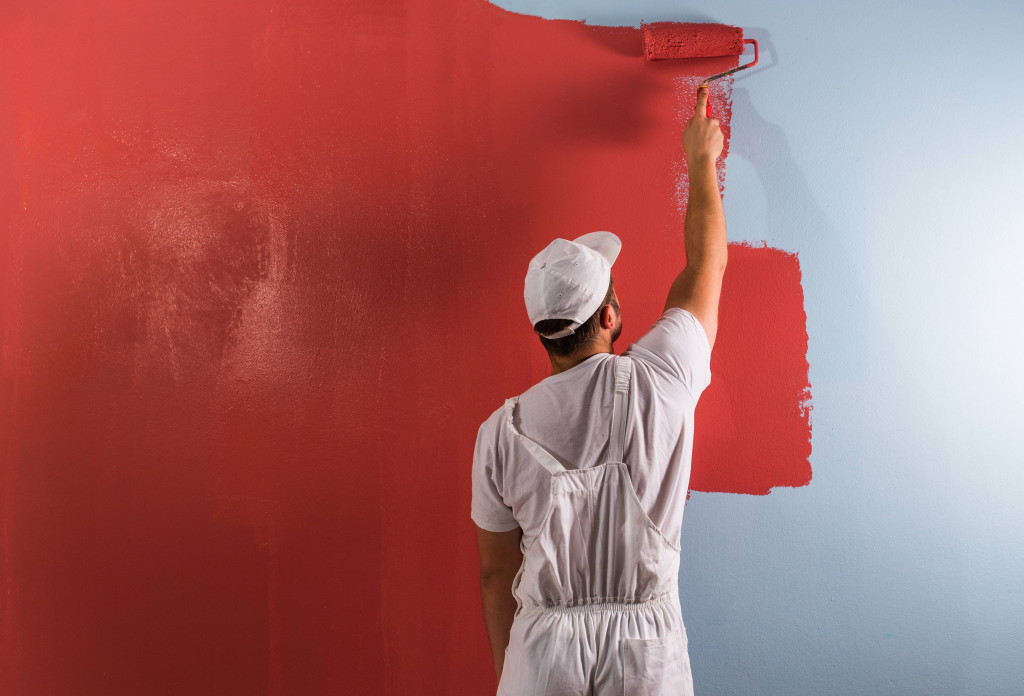Stay Ahead With New Paint Trends: Mixing Techniques for Modern Interiors

The Rise of Shade Gradients in Inside Design
As designers significantly look for ingenious methods to improve rooms, the increase of color gradients in indoor layout has gathered considerable focus. This method, defined by the smooth change in between two or more shades, permits for a vibrant aesthetic impact that can change an average area into a vivid environment. Shade gradients can stimulate emotions, influence perceptions of area, and create focal points, making them a flexible choice for various design styles.
The application of gradients expands beyond walls; they can be effectively employed in furniture, textiles, and accessories. Developers often explore differing tones to attain depth and intrigue, attracting an array of aesthetics from minimalist to diverse. Additionally, the adaptability of slopes enables their use in both residential and industrial settings, accommodating varied clientele. As patterns evolve, the use of shade slopes signifies a shift in the direction of even more customized and meaningful indoor spaces, showing specific tastes and way of livings.
Welcoming Ombre Techniques for a Dynamic Look
Ombre techniques have emerged as a charming option for those looking to add depth and movement to modern insides. This gradient result changes efficiently from one shade to an additional, developing an aesthetically striking prime focus in any type of space. Developers value ombre for its flexibility; it can be related to wall surfaces, furnishings, or perhaps decorative accents, enabling special expressions of design.
The strategy functions specifically well with soft hues, supplying a serene ambiance, while strong shades can invigorate a room. Home owners can trying out various color combinations, choosing different tones for a remarkable effect or unified tones for a subtle result. The application of ombre is not restricted to a single wall; it can extend throughout a space, enhancing the assumption of area and light.
As a contemporary fad, ombre methods deal with varied tastes, allowing people to individualize their interiors and welcome imagination in their design strategy. corpus christi tx paint shop.
Distinctive Wall Surfaces: Layering Paint for Deepness and Interest
Textured wall surfaces can greatly improve the aesthetic allure of modern-day insides by including depth and interest. Methods for producing appearance, thoughtful shade combinations, and the right tools for layering are necessary parts in achieving this effect. Checking out these components enables a personalized and dynamic technique to interior decoration.
Strategies for Texture Creation
Creating visual interest in interior spaces typically depends upon the artistic application of structure. Numerous strategies can be used to attain this, such as sponging, dustcloth rolling, and stippling. Sponging entails making use of a damp sponge to use a 2nd shade over a base coat, creating a soft, multicolor effect. Rag rolling, on the other hand, utilizes a rolled cloth to use paint, resulting in a much more vibrant texture. Stippling employs a tight brush or tool to swab paint onto the surface area, developing an unique pattern. Furthermore, layering various coatings, such as matte and glossy, can enhance deepness. These techniques not just give visual appeal yet additionally add to the general ambiance of modern insides, encouraging a responsive experience.
Color Mixes for Effect
Layering paint not only boosts structure but additionally opens a world of shade combinations that can substantially affect the state of mind of a space. By blending corresponding tones, developers can develop an unified effect that welcomes warmth or coolness, relying on the desired atmosphere. As an example, abundant planet tones matched with soft pastels can stimulate a calm atmosphere, while vibrant, different colors can include vibrancy and energy. Additionally, including metallic or glossy surfaces within the layers can introduce a vibrant visual aspect, capturing light and enhancing the deepness of the color design. Ultimately, thoughtful shade combinations through layering paint offer an opportunity to express specific style while changing regular walls right into enchanting centerpieces.
Tools for Layering Impact
Numerous devices are vital for attaining a successful layering effect in paint applications, which can transform walls right into charming visual experiences. Rollers and brushes are basic, with diverse dimensions allowing for different textures and finishes. Specialty devices like rags and sponges can develop unique patterns and depth, while palette knives offer precision for more defined lines. For bigger locations, utilizing a stippling brush can add a complex surface. Furthermore, spray guns can efficiently use multiple layers for a smooth, also layer. Painters should likewise think about painter's tape to produce clean edges between layers. By making use of the right devices, one can properly boost the visual allure of interiors, making each wall an interesting centerpiece.

The Power of Color Blocking in Modern Spaces
As contemporary interior design continues to develop, color obstructing becomes an effective method that can transform spaces with bold visual influence. This approach includes the calculated positioning of contrasting shades to produce defined areas within an area, improving both the aesthetic appeal and functionality of the room. benjamin moore paint store corpus christi. By making use of big swathes of color, designers can guide the eye and emphasize building elements, leading to a dynamic ambience
Shade barring is not restricted to walls; it can additionally be related to furniture and decor, permitting for countless personalization. Pairing a vivid color with a neutral tone can create a striking focal factor while maintaining equilibrium. This method encourages creativity, enabling homeowners to share their characters with special color mixes. Inevitably, my explanation shade blocking functions as an effective method to rejuvenate modern-day insides, making spaces really feel fresh, energised, and visually engaging.
Integrating Metallics for an Extravagant Finish
Exactly how can metallics boost the sophistication of modern insides? Metallic finishes serve as a striking centerpiece, including deepness and aesthetic interest to spaces. They can transform a standard space into a classy retreat with the subtle interplay of light and reflection. Designers usually advise incorporating metallics in accent walls, ceilings, or furnishings to develop an extravagant environment without frustrating the area.
Different metal tones-- such as gold, silver, and bronze-- use versatility, permitting home owners to personalize their aesthetic. A soft gold can present heat, while a smooth silver can provide a contemporary touch. When matched with neutral tones, metallics enhance the overall layout, providing an innovative contrast that draws the eye.
Including metal paint into trim or moldings can also boost building details, developing a sleek surface. Eventually, the tactical usage of metallics can instill modern insides with beauty and refinement, making them truly enchanting.
Imaginative Use of Stencils for Unique Patterns
Changing walls with stencils can infuse modern-day insides with unique personality and style. This artistic strategy enables developers and property owners to produce customized patterns that show individual aesthetic appeals. Patterns can range from detailed geometric styles to wayward motifs, allowing a wide range of expressions. By picking contrasting colors, patterns can elevate a space's aesthetic charm and offer as centerpieces without frustrating the space.
In addition, stencils are flexible; they can be related to various surfaces, including wall surfaces, furnishings, and even ceilings. This flexibility makes stenciling an optimal option for do it yourself fanatics aiming to enhance their living rooms economically. In addition, the convenience of application and elimination allows for experimentation, enabling people to revitalize their style with very little initiative. Inevitably, innovative use of stencils not just changes average surfaces however also provides a possibility for self-expression, making them a trending option in modern indoor style.
Blending Matte and Shiny Finishes for Comparison
The interaction of matte and glossy surfaces can develop a striking visual dynamic in modern-day interiors. Developers commonly use this comparison to enhance architectural features and define areas. Matte coatings, with their soft, non-reflective high quality, can create a feeling of heat and intimacy, making them perfect for wall surfaces and larger surface areas. On the other hand, shiny surfaces reflect light, including vibrancy and depth, making them suitable for accents such as trim, moldings, or furniture.
The mix of these structures can lead the eye and highlight centerpieces within a room. For example, pairing a matte-painted wall surface with shiny cabinets can develop a sophisticated equilibrium. Furthermore, the mindful application of both finishes can evoke numerous state of minds while enhancing the general aesthetic. As home owners progressively More Info look for personalized areas, mixing matte and shiny finishes provides a functional approach to achieving modern style and visual rate of interest in interior decoration.
Frequently Asked Inquiries
What Devices Are Best for Blending Paint Strategies?
A selection of devices are perfect for blending paint click here for more strategies, consisting of foam rollers, brushes with soft bristles, sponge applicators, and airbrushes. Each tool offers unique results, improving the blending process for different artistic applications.
Just How Can I Deal With Blending Mistakes?
To deal with blending mistakes, one should lightly sand the damaged location, use a guide if essential, and afterwards carefully reapply paint using a soft brush or sponge to achieve a smooth shift and bring back the wanted impact.
Are There Particular Paint Brands Recommended for Blending?
Several paint brands are recommended for blending, consisting of Benjamin Moore, Sherwin-Williams, and Behr. These brand names supply premium surfaces and a large range of shades that promote smooth changes and efficient blending strategies in different indoor tasks.
Can I Mix Paint Without Professional Help?
Yes, blending paint without professional help is feasible. With practice and the right devices, people can accomplish desirable effects. Various online tutorials and overviews can help in grasping blending techniques for individual jobs.

The Length Of Time Does Blended Paint Last on Walls?
Blended paint can last anywhere from five to ten years on walls, depending upon aspects such as the quality of paint utilized, surface area preparation, and environmental problems. Routine upkeep usually boosts long life and look.
As developers significantly seek innovative ways to enhance spaces, the rise of color slopes in indoor layout has actually amassed substantial focus. The strategy functions specifically well with soft tones, giving a calm ambiance, while vibrant shades can stimulate an area. Techniques for producing structure, thoughtful shade mixes, and the right devices for layering are crucial parts in attaining this effect. Layering paint not just improves appearance yet additionally opens up a globe of shade mixes that can substantially influence the state of mind of a room. As contemporary interior layout proceeds to advance, shade obstructing emerges as an effective method that can transform rooms with strong aesthetic effect.